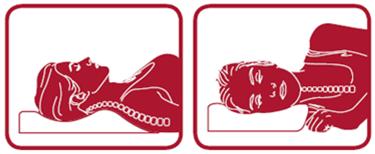Get the Best from a Good Night's Rest
Getting a good night's rest is vital for our health and wellbeing. To help avoid postural problems and aches caused by sleeping patterns, McTimoney Chiropractic Association brings you this simple guide to help you ensure a better night's rest.
Is it Time for a New Bed?
Are you sleeping as well as you did a year ago?
There is a good change that your bed is contributing to this.
Does your mattress sag in the middle?
If it does, then your spine and pelvis may not be properly supported at night.
Do you wake up with aches and pains that gradually wear off as the day progresses?
Your bed may be losing the support that it has given you previously, suggesting the fillings are losing their natural spring.
Do you sleep better when staying away in other beds?
This may be a signal that it is time to change your bed. A mattress that is too firm or too soft can be a cause of discomfort and disturb your sleep. A medium firm mattress may be a good option but remember that what suits one person, may not suit another. A good mattress should offer support allowing correct alignment of the spine and relaxation of the body. Dunlopillo mattresses mould to the shape of your body giving instant pressure relief and comfort without disturbing your sleep. If you become too hot or cold during sleep, you should consider a Dunlopillo bed. These mattresses are made from Dunlopillo latex, are naturally breathable and adjust to the changes in your body temperature.
When choosing a new mattress, lie on the mattress for at least 10 minutes, in your normal sleeping positions. The Sleep Council suggests the following test to see if the mattress is right for you:
-
- Primarily, set aside enough time to shop correctly and if it is for two, take your partner.
-
- Ensure you have the right sized bed for you and your partner.
-
- Always shop for the best value, not the lowest price
-
- Buy the base and mattress together
-
- Lie on the mattress in the position you sleep and not just on your back.
-
- Lying flat on your back, slide the flat of your hand into the hollow of your back if your hand slides in easily, the mattress may be too firm for you.
-
- If it is difficult to slide your hand into the hollow of your back, it suggests that the mattress may be too soft for you.
A full guide to buying a new mattress is available from the Sleep Council at www.sleepcouncil.com.
Sleeping Position
Sleeping gives the muscles a chance to rest from daily tension. Good positioning whilst sleeping encourages this. If you aim to achieve the best symmetry and balance of your body when sleeping, then the muscles will be at their most relaxed.
Sleeping on your front: Stresses the neck and may cause stiffness on waking and misalignments in the vertebrae. If you are going to sleep this way, ensure that your pillow allows you to keep your spine neutral and correctly supported.
Sleeping on your back: Your spine is lengthened, the shoulders are relaxed, the rib cage is free to expand and muscles are lengthened and relaxed. A pillow under the knees also relaxes the back muscles.
Side Sleeping (Foetal Position): This mirrors the recovery position to take undue stresses off the body. A pillow between the knees will prevent the spine and pelvis from twisting.
Pillows
Choose a pillow that offers support without being too firm and always allow the neck to be in the neutral position so its in the same position in relation to your spine and shoulders as you would have standing up with good posture.
Pillows that are too deep or too slim can stress the neck muscles. This can narrow your airway and may lead to snoring and disturbed sleep. If you sleep on your back or front, you will need slimmer pillows than if you sleep on your side.
Dunlopillo pillows mould to the head and neck giving support, helping relaxation and maintaining body temperature for a comfortable night's sleep.
Avoid buying economy pillows as they start out at a certain depth but then pack down into something thinner and lumpy over time - and even from one hour to another as the night progresses.

Environment
Your bedroom should be a relaxed, calm environment, well ventilated and without draughts. If you watch television in bed, ensure you are in a position that is comfortable for your neck and back. Try to avoid slouching against the pillows creating a banana shape in your spine. This stresses your spine and the muscles of your back, neck and shoulders. Many people find that a specialist pillow or back rest can ensure their comfort when sitting in bed. A recent study also noted that body mass index, obstructive sleep apnoea, smoking, alcohol and hypertension can all reduce sleep quality.
When Getting Up in the Morning
Before getting out of bed, take time to stretch just like cats do. This will start to warm up your muscles and limber up your back before you start the day. This could help reduce the risk of back strain.